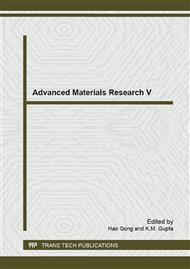[1]
J.S. Kong and D.M. Frangopol in: Life-cycle reliability-based maintenance cost optimization of deteriorating structures with emphasis on bridges, Journal of Structural Engineering, 129(6), 818-828 (2003).
DOI: 10.1061/(asce)0733-9445(2003)129:6(818)
Google Scholar
[2]
B.V. Rangan, Engineering properties of geopolymer concrete, Chapter 11 in: Provis, J. L., & Van Deventer, J.S.J. (Eds. ), Geopolymers: structures, processing, properties and industrial applications, Elsevier (2009).
Google Scholar
[3]
C. Menna, D. Asprone, C. Ferone, F. Colangelo, A. Balsamo, A. Prota, R. Cioffi, G. Manfredi in:. Use of geopolymers for composite external reinforcement of RC members, Composites Part B: Engineering, 45(1), 1667-1676 (2013).
DOI: 10.1016/j.compositesb.2012.09.019
Google Scholar
[4]
RILEM Technical Committee 247 - Durability testing of alkali-activated materials, http: /www. rilem. org/gene/main. php?base=8750&gp_id=290 (access on: 27th September 2014).
Google Scholar
[5]
J. He, Y. Jie, J. Zhang, Y. Yu, G. Zhang in: Synthesis and characterization of red mud and rice husk ash-based geopolymer composites, Cement and Concrete Composites, 37-108-118 (2013).
DOI: 10.1016/j.cemconcomp.2012.11.010
Google Scholar
[6]
B. Molino, A. De Vincenzo, C. Ferone, F. Messina, F. Colangelo, R. Cioffi in: Recycling of clay sediments for geopolymer binder production. A new perspective for reservoir management in the framework of Italian legislation: the Occhito reservoir case study. Materials - Special Issue Recycled Materials, (2014).
DOI: 10.3390/ma7085603
Google Scholar
[7]
G. Xiaolu, S. Huisheng, L. Maosong and D. Wenjing in: Effects of calcium contents in class C fly ash geopolymer, Advanced Materials Research Vol. 68, 10. 4028 pp.508-513, (2013).
Google Scholar
[8]
C. Ferone, F. Colangelo, F. Messina, L. Santoro, R. Cioffi in: Recycling of pre-washed municipal solid waste incinerator fly ash in the manufacturing of low temperature setting geopolymer materials, Materials, 6 (8), 3420-3437 (2013).
DOI: 10.3390/ma6083420
Google Scholar
[9]
M. Migliaccio, G. Ferrara, A. Gifuni, A. Sorrentino, F. Colangelo, C. Ferone, R. Cioffi, F. Messina in: Shielding effectiveness tests of low-cost civil engineering materials in a reverberating chamber, Progress In Electromagnetics Research B 54, 227-243 (2013).
DOI: 10.2528/pierb13071703
Google Scholar
[10]
C. Ferone, F. Colangelo, F. Messina, F. Iucolano, B. Liguori, R. Cioffi in: Coal combustion wastes reuse in low energy artificial aggregates manufacturing, Materials 2013, 6 (11), 5000-5015 (2013).
DOI: 10.3390/ma6115000
Google Scholar
[11]
Y. Wang, Z. Qinghua, G. Yong in: Trajectory and driving factors for GHG emissions in the Chinese cement industry, Journal of Cleaner Production, 53, 252-260 (2013).
DOI: 10.1016/j.jclepro.2013.04.001
Google Scholar
[12]
G. Nestovito in: Seismic response of an existing viaduct in Italy, Ph.D. dissertation thesis, Department of Engineering, University of Naples Parthenope, Italy (2014), in press.
Google Scholar
[13]
G. Maddaloni, N. Caterino, G. Nestovito, A. Occhiuzzi in: Use of seismic early warning information to calibrate variable dampers for structural control of a highway bridge: evaluation of the system robustness, Bulletin of Earthquake Engineering, 10. 1007/s10518-013-9510-z (2012).
DOI: 10.1007/s10518-013-9510-z
Google Scholar
[14]
G. Maddaloni, N. Caterino, G. Nestovito and A. Occhiuzzi in: Regional-based control algorithms using early warning information for seismic protection of a highway bridge, Proceedings of 4th ECCOMAS Thematic Conference on Computational Methods in Structural Dynamics and Earthquake Engineering, Kos Island, Greece (2013).
DOI: 10.7712/120113.4771.c1713
Google Scholar
[15]
Circolare n. 384: Loads standard for bridges, Ministry of Infrastructure (1962).
Google Scholar
[16]
The Ministry of Infrastructure: New Technical standards for Construction, N.T.C. (2008).
Google Scholar
[17]
G.M. Verderame, A. Stella and E. Cosenza in: Le proprietà meccaniche degli acciai impiegati nelle strutture in cemento armato degli anni 60, X National Conference of ANIDIS Seismic Engineering in Italy,. 9-13 September, Potenza and Matera, Italy (2001b).
Google Scholar
[18]
Sap2000 Computer and structures, Structural analysis program and reference manual (2013).
Google Scholar
[19]
EN 1998, Eurocode 8: design of structures for earthquake resistance – part 2, bridges.
Google Scholar
[20]
J.B. Mander, J. Kim, S. Chen, G. Premus in: Response of steel bridge bearings to reversed cyclic loading, Technical Report National Center Earthquake Engineering Research 96-0014 (1996).
Google Scholar
[21]
Circolare n. 617: Instructions for the application of technical standards for new construction (2009).
Google Scholar


